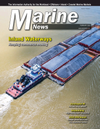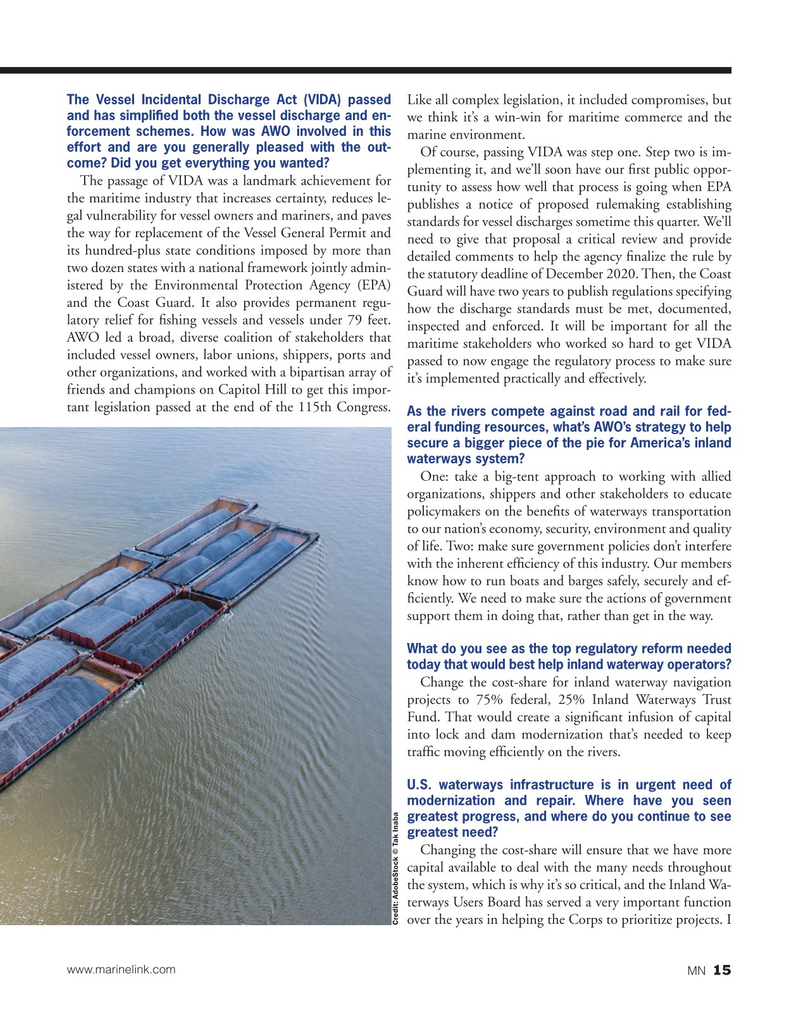
Page 15: of Marine News Magazine (February 2020)
Pushboats,Tugs & Assist Vessels
Read this page in Pdf, Flash or Html5 edition of February 2020 Marine News Magazine
Like all complex legislation, it included compromises, but
The Vessel Incidental Discharge Act (VIDA) passed and has simpli? ed both the vessel discharge and en- we think it’s a win-win for maritime commerce and the forcement schemes. How was AWO involved in this marine environment.
effort and are you generally pleased with the out-
Of course, passing VIDA was step one. Step two is im- come? Did you get everything you wanted?
plementing it, and we’ll soon have our ? rst public oppor-
The passage of VIDA was a landmark achievement for tunity to assess how well that process is going when EPA the maritime industry that increases certainty, reduces le- publishes a notice of proposed rulemaking establishing gal vulnerability for vessel owners and mariners, and paves standards for vessel discharges sometime this quarter. We’ll the way for replacement of the Vessel General Permit and need to give that proposal a critical review and provide its hundred-plus state conditions imposed by more than detailed comments to help the agency ? nalize the rule by two dozen states with a national framework jointly admin- the statutory deadline of December 2020. Then, the Coast istered by the Environmental Protection Agency (EPA) Guard will have two years to publish regulations specifying and the Coast Guard. It also provides permanent regu- how the discharge standards must be met, documented, latory relief for ? shing vessels and vessels under 79 feet. inspected and enforced. It will be important for all the
AWO led a broad, diverse coalition of stakeholders that maritime stakeholders who worked so hard to get VIDA included vessel owners, labor unions, shippers, ports and passed to now engage the regulatory process to make sure other organizations, and worked with a bipartisan array of it’s implemented practically and effectively.
friends and champions on Capitol Hill to get this impor- tant legislation passed at the end of the 115th Congress.
As the rivers compete against road and rail for fed- eral funding resources, what’s AWO’s strategy to help secure a bigger piece of the pie for America’s inland waterways system?
One: take a big-tent approach to working with allied organizations, shippers and other stakeholders to educate policymakers on the bene? ts of waterways transportation to our nation’s economy, security, environment and quality of life. Two: make sure government policies don’t interfere with the inherent ef? ciency of this industry. Our members know how to run boats and barges safely, securely and ef- ? ciently. We need to make sure the actions of government support them in doing that, rather than get in the way.
What do you see as the top regulatory reform needed today that would best help inland waterway operators?
Change the cost-share for inland waterway navigation projects to 75% federal, 25% Inland Waterways Trust
Fund. That would create a signi? cant infusion of capital into lock and dam modernization that’s needed to keep traf? c moving ef? ciently on the rivers.
U.S. waterways infrastructure is in urgent need of modernization and repair. Where have you seen greatest progress, and where do you continue to see greatest need?
Changing the cost-share will ensure that we have more capital available to deal with the many needs throughout the system, which is why it’s so critical, and the Inland Wa- terways Users Board has served a very important function over the years in helping the Corps to prioritize projects. I
Credit: AdobeStock © Tak Inaba www.marinelink.com 15MN

 14
14

 16
16
